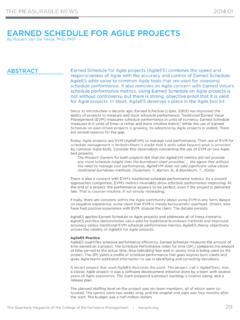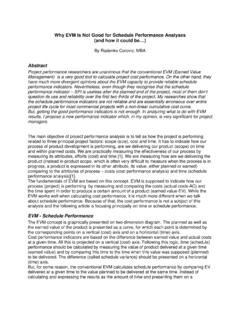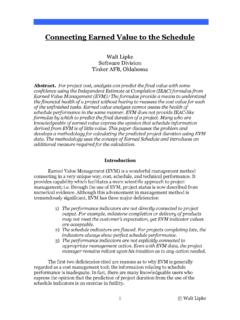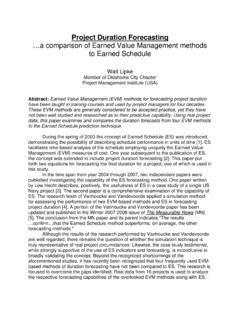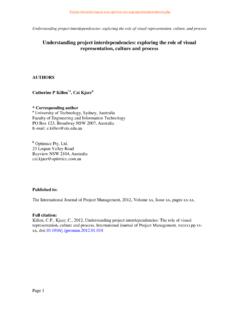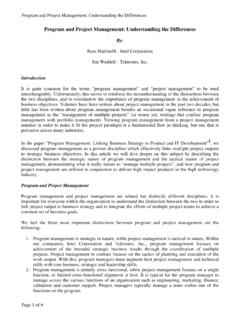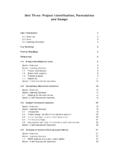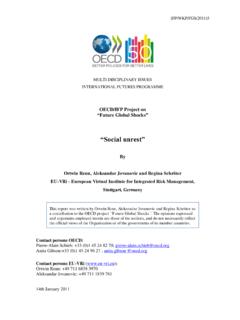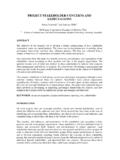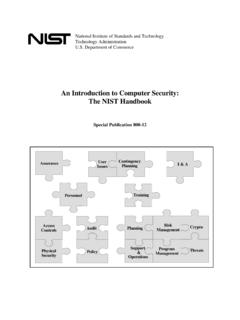Transcription of Schedule Adherence v5b
1 Schedule Adherence a useful measure for project management Walt Lipke PMI Oklahoma City Chapter Abstract: Earned Value Management (EVM) is a very good method of project management. However, EVM by itself cannot provide information as to how the Schedule is being accomplished. project accomplishment not in accordance with the planned Schedule frequently has adverse repercussions; cost increases and duration is elongated. Thus, managers have a need to more fully understand project performance. This paper utilizes the new practice of Earned Schedule to discuss a proposed measure for further enhancing the practice of EVM. The measure, Schedule Adherence , provides additional early warning information to project managers, thereby enabling improved decision making and enhancing the probability of project success. Development of a plan for executing a project is a difficult undertaking.
2 When the plan is being created, a work flow is envisioned along with constraints and resource availability. There is a considerable amount of effort invested in decomposing the constituents of the plan into manageable components and work packages. Detailed examination of the tasks themselves is made to prepare reasonable estimates for their cost and duration. Oftentimes, planning teams use historical project records, heuristics and statistical algorithms to determine best and worst case probable outcomes. Furthermore, to assure that the best possible plan is created, technical experts may be employed to make the estimates as accurate as possible. Before assignments can be made to the team members of a project , the timing of their actions must be known along with their interdependencies. The intricate mechanism for consolidating all of this information and making it understandable to the project team, and senior management, as well, is the Schedule .
3 The Schedule is an embodiment of our best understanding of how to accomplish the project a truly important document. Possibly, the Schedule is the single most important document pertaining to the project and it likely has more to do with success than any other aspect. Well then .if the planned Schedule is so crucial to project success, it follows that project managers should do their utmost to ensure project execution conforms to it. Assuming the planned Schedule is the most efficient path for executing the project , any deviation leads to inefficiency and very likely other problems .such as constraint reduced production, idle time, skills mismatch and poor quality output, in turn, requiring rework. Thus, there is an extremely compelling case for following the planned Schedule . This paper presents a proposed method for measuring the conformance, or Adherence , for the Schedule execution of a project .
4 Utilizing the method and measure, the project manager has a better understanding of how well the execution follows the sequence and precedence of the tasks in the baseline Schedule . Having an indicator for Schedule Adherence provides additional early warning information for managers to act upon. Schedule Performance Efficiency versus Schedule Adherence What is meant by Schedule Adherence ? Does it mean that the project is performing such that objectives are achieved at the time predicted or planned? Certainly project managers want to know that interim products are being produced and delivered on time. This type of Schedule performance indicator can be made a number of different ways, such as portion or percent of milestones, objectives, or interim products achieved on time. In fact, the Earned Value Management (EVM) Schedule Performance Indicator (SPI) is of this However, SPI is much more resolute than the very coarse measures mentioned; its increment of measure is cost, earned and planned.
5 This discussion for SPI is equally applicable to the time-based Schedule performance efficiency indicator from Earned Schedule (ES), SPI(t).2. All of these indicators, including SPI and SPI(t), describe the efficiency of achieving the plan. However, they do not provide information about how the products, milestones, objectives or earned value were achieved. For example, these indicators cannot describe whether or not completion of milestone 2 followed milestone 1. If the milestone Schedule indicates that at status period 3 we should have completed two milestones and we have completed two, it would appear from the indicator (milestone percent completed = 100 percent), that all is well. But, what if the two milestones are numbers one and three, while the second milestone is still in work? Is there anything possibly wrong? After all, the project has met its two milestone objective.
6 For the EVM Schedule efficiency indicator, SPI, there is no concern as to whether the earned value (EV) accrued matches the expectation of the Schedule . In most cases, project managers would celebrate an SPI = because it is so seldom achieved, and consequently would not question whether the EV accrued is, in fact, the expected PV. Again, the question is raised, Should the project manager be concerned with the performance sequence, , how the achievement occurred? Does it make any difference? Over the last 20 years, nearly every industry experienced several initiatives intended to improve project performance and product quality: Statistical Process Control, Total Quality Management, the Software Engineering Institute Capability Maturity Model (CMM ), and the International Organization Standard for Quality Management Systems, ISO 9001. The fundamental idea from all of these process improvement efforts is: undisciplined execution leads to inefficient performance and defective products.
7 Doesn't this thinking apply to project plans, too? Of course it does; the planned Schedule describes the execution process. Therefore, it is not enough to measure the execution efficiency. Additionally, project managers (PM) need to know how well the process is being followed. By maintaining process integrity, PMs can maximize the project 's performance, and minimize its rework and delivery of defective products. An indicator for Adherence to the Schedule provides the measure needed by PMs for monitoring and controlling the project execution. Measuring and Indicating Schedule Adherence The idea for measuring Schedule Adherence is simply stated in this question, Did the accomplishment match exactly the expectation from the planned Schedule ? . This is not the same as the preceding discussion of Schedule performance efficiency, where the volume of actual work accomplishment is compared to the expected volume from the Schedule .
8 Schedule Adherence is a more restrictive measure, and is independent from performance efficiency. A recent enhancement to EVM, Earned Schedule (ES), provides a means to measure Schedule Adherence . ES is derived from two measures of EVM, planned value (PV) and earned value (EV) [2]. The accumulated planned value from the project start to its planned completion is the performance measurement baseline (PMB) [1]. ES is the time duration associated with the PMB where the PV is equal to the EV accrued. The concept of ES is illustrated by Figure 1. Arrow A projects the accrued value of EV onto the PMB to identify the point at which PV equals EV. Arrow B identifies the time at which PV equals the EV accrued; , the planned duration earned or ES. The time at which the EV accrued appears is period 7. Whereas ES is determined to be the duration of 5 periods; , the time measure from the PMB where PV is equal to the EV.
9 Accrued at Time Now, or Actual Time (AT). Two comparative measures, SVt and SVc, are shown in the diagram to illustrate the difference between the cost-based and time-based indicators of EVM and ES, respectively. The traditional EVM Schedule variance is SVc, while the time-based Schedule variance from ES is From the numbers shown in the diagram, SVt can be easily computed: SVt = ES AT = 5 7 = 2. Assuming the units are months, the project is 2 months behind its planned Schedule . $ Time Now The idea is to determine the time at which the EV accrued should have occurred. A SVc PV. EV B. ES SVt AT. 1 2 3 4 5 6 7 8 9 10. Figure 1. Earned Schedule Concept The performance expectation for the planned Schedule is embodied in the PMB. This is a consequence of the PMB being the result from summing time phased PV. across all tasks in the Schedule . Figure 2 is used to illustrate the relationship.
10 The figure shows a network Schedule at the top with the PV curve beneath it. The connection between EVM and the Schedule provided by Earned Schedule is remarkable. Regardless of the project 's actual position in time, we have information describing the portion of the planned Schedule which should have been accomplished. That is, for a claimed amount of EV at a status point AT, the portion of the PMB which should be accomplished is identified by ES. Another way of describing this relationship is the value of ES indicates where the task performance of the project should be for that amount of duration of the planned Schedule . As shown by Figure 2, specific tasks make up that portion of the Schedule . The darker shaded areas of the task blocks indicate the portions planned to be completed. If the Schedule is adhered to we will observe in the actual performance the identical tasks at the same level of completion as the tasks which make up the plan portion identified by ES.

